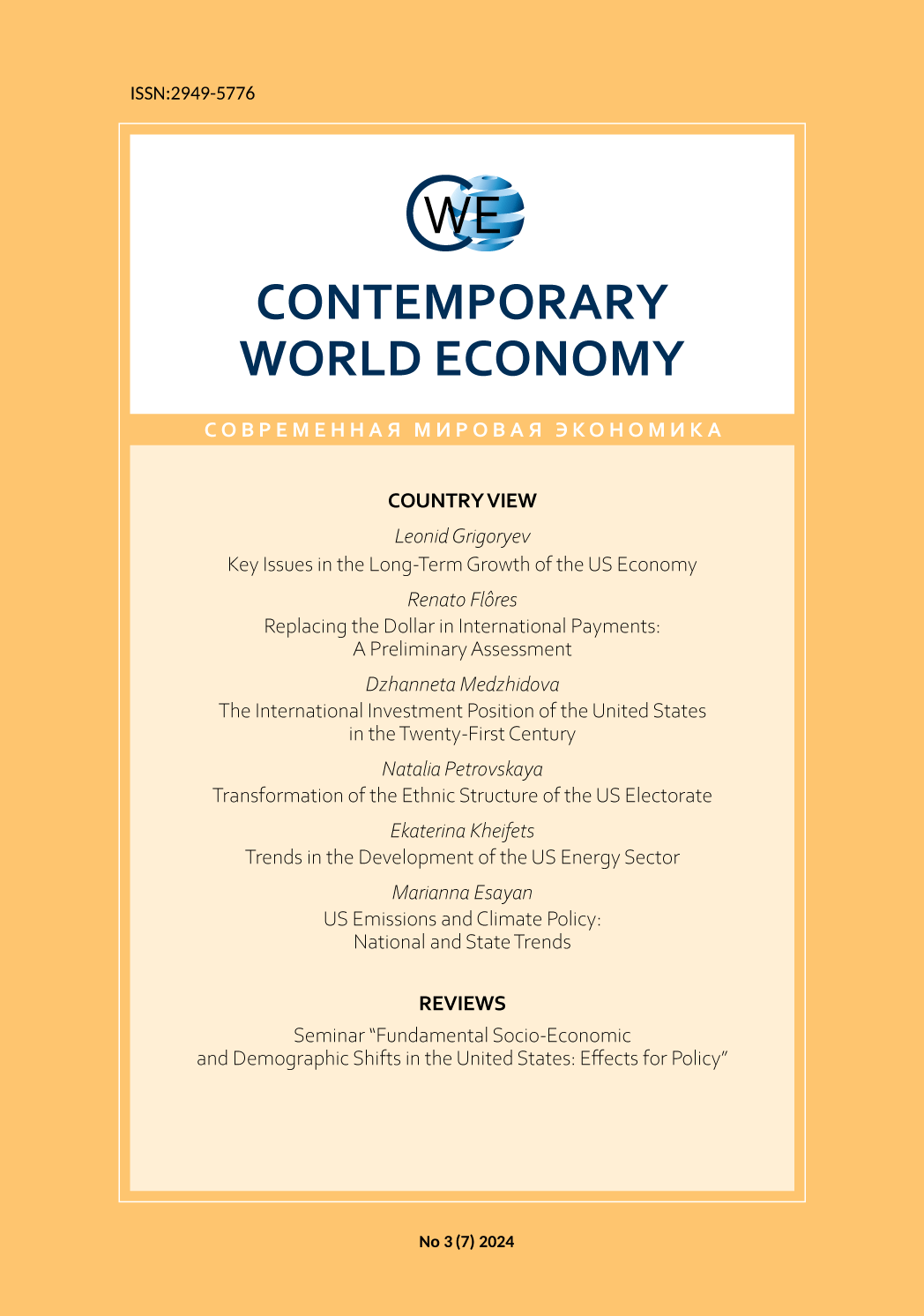The International Investment Position of the United States in the Twenty-First Century
Abstract
The accumulation process in the United States is contingent upon the substantial opportunities presented by domestic corporations, encompassing amortization and retained earnings, in addition to both internal and external sources of financing. The present study is dedicated to the analysis of the evolution of the international investment position of the United States since the beginning of the 21st century. The objective of the present study is to identify changes in the structure of US liabilities and assets during three key periods: 2000–2007, 2007–2019, 2019–2023 in the context of global processes and the country’s monetary policy. During the period spanning from 2000 to 2023, net investment inflows amounted to nearly $20 trillion at “moderate market prices,” discounted for stability and security. Concurrently, financial investment in the US economy is predominantly concentrated in the forms of equity, investment funds, and long-term debt. An analysis of the geographical distribution of US portfolio investments reveals the stability of the nation’s primary partners, with developed countries and offshore financial centers predominating. However, during the period under review, there were changes in financial flows between the US and developing countries, primarily the BRICS countries.
Downloads
References
Aliber, R., 2020. Why Did the United States Evolve from the Largest International Creditor in 1980 to the Largest International Debtor in 1990? Atlantic Economic Journal, Vol. 48. P. 410. DOI: 10.1007/s11293-020-09695-x.
Avdjiev, S., Bruno, V., Koch, C., Shin, H. S., 2019. The Dollar Exchange Rate as a Global Risk Factor: Evidence from Investment. IMF Economic Review, Vol. 67. P. 151-173. DOI: 10.1057/s41308-019-00074-4.
BEA. International Investment Position of the United States. Available at: https://apps.bea.gov/iTable/?reqid=19&step=2&isuri=1&categories=survey
Bernanke, B. S., Bertaut, C. C., DeMarco, L., Kamin, S. B., 2011. International Capital Flows and the Return to Safe Assets in the United States, 2003-2007. FRB International Finance Discussion Paper. No. 1014. Available at: https://papers.ssrn.com/sol3/papers.cfm?abstract_id=1837780
Blanchard, O., Milesi-Ferretti, G. M., 2009. Global Imbalances: In Midstream? IMF Staff Position Note. Available at: https://www.imf.org/external/pubs/ft/spn/2009/spn0929.pdf
Federal Reserve Bank of New York, 2024. Foreign Portfolio Holdings of US Securities. Available at: https://ticdata.treasury.gov/resource-center/data-chart-center/tic/Documents/shla2023r.pdf
Fichtner, J., 2016. The anatomy of the Cayman Islands offshore financial center: Anglo-America, Japan, and the role of hedge funds. Review of International Political Economy, Vol. 23. DOI: 10.1080/09692290.2016.1243143.
Gómez-Cram, R., Kung, H., Lustig, H., 2024. The Dollar, Financial Conditions, and the Return on US Assets. Federal Reserve Bank of Kansas City. Available at: https://www.kansascityfed.org/Jackson%20Hole/documents/10341/Hanno_Lustig_Paper_JH.pdf
Gourinchas, P.-O., Rey, H., 2007. From World Banker to World Venture Capitalist: US External Adjustment and the Exorbitant Privilege. In: G7 Current Account Imbalances: Sustainability and Adjustment / Clarida R. H. (ed.). University of Chicago Press. P. 11. Available at: https://www.nber.org/system/files/chapters/c0121/c0121.pdf
Grigoryev, L.M., Zharonkina, D.V., Maykhrovich, M.-Y., Kheifets, E.A., 2024. Mechanism of regime changes of global inflation in 2012–2023. Moscow University Economics Bulletin. No 1. P. 72-95 (in Russian). Available at: https://doi.org/10.55959/MSU0130-0105-6-59-1-4
Grigoryev, L.M., Morozkina, A.K., 2021. Successful unsustainable industrialization of the world: 1880-1913. Moscow: Nestor-Istoria (in Russian).
Grossman, A., Simpson, M., Brown, C. J., 2009. The impact of deviation from relative purchasing power parity equilibrium on US foreign direct investment. The Quarterly Review of Economics and Finance, Vol. 49, No. 2. P. 521-550. DOI: 10.1016/j.qref.2008.02.001.
Higgins, M., Klitgaard, T., Tille, C., 2006. Borrowing without Debt? Understanding the US International Investment Position. Federal Reserve Bank of New York Staff Reports. Staff Report no. 271. 2006. Available at: https://www.newyorkfed.org/medialibrary/media/research/staff_reports/sr271.pdf
Jackson, J.K., 2009. Foreign Ownership of US Financial Assets: Implications of a Withdrawal. Congressional Research Service. Available at: https://ecommons.cornell.edu/server/api/core/bitstreams/9267602b-39ca-4acb-962e-bd5fa43c0cae/content
Janus Henderson, 2024. Global Perspectives on Economic Outlook. Available at: https://cdn.janushenderson.com/webdocs/H052332_0124_EN.pdf
Janus Henderson, 2022. Investment Insights. Available at: https://cdn.janushenderson.com/webdocs/H049590_0222+-+English+Global.pdf
Lane, R. R., Milesi-Ferretti, G. M., 2006. The External Wealth of Nations Mark II: Revised and Extended Estimates of Foreign Assets and Liabilities, 1970-2004. IMF Working Paper No. 2006/069. Available at: https://www.imf.org/en/Publications/WP/Issues/2016/12/31/The-External-Wealth-of-Nations-Mark-II-Revised-and-Extended-Estimates-of-Foreign-Assets-and-18942
Lipsey, R. E., 1977. Changing Patterns of International Investment in and by the United States. NBER Working Paper No. 2240. Available at: https://www.nber.org/system/files/working_papers/w2240/w2240.pdf
Miran, S., Roubini, N., 2024. Activist Treasury Issuance and the Tug-of-War Over Monetary Policy. July 2024. Hudson Bay Capital Research. Access mode: https://www.hudsonbaycapital.com/documents/FG/hudsonbay/research/635102_Activist_Treasury_Issuance_-_Hudson_Bay_Capital_Research.pdf
OECD, 2018. FDI. Available at: https://www.oecd.org/investment/investment-policy/FDI-in-Figures-July-2018.pdf
Perelstein, J., 2009. Macroeconomic Imbalances in the United States and Their Impact on the International Financial System. The Levy Economics Institute Working Paper. Available at: https://papers.ssrn.com/sol3/papers.cfm?abstract_id=1335287
Roberts, S.M., 1995. Small Place, Big Money: The Cayman Islands and the International Financial System. Economic Geography, Vol. 71, No. 3. DOI: 10.2307/144310.
Summers, L., 2006. Reflections on Global Account Imbalances and Emerging Markets Reserve Accumulation. L.K. Jha Memorial Lecture, Reserve Bank of India, Mumbai, India. Available at: https://www.harvard.edu/president/news-speeches-summers/2006/reflections-on-global-account-imbalances-and-emerging-markets-reserve-accumulation/#figure1
Swiston, A. J., 2005. A Global View of the US Investment Position. IMF Working Paper WP/05/181. Available at: https://www.imf.org/en/Publications/WP/Issues/2016/12/31/A-Global-View-of-the-U-S-18524



1.jpg)

